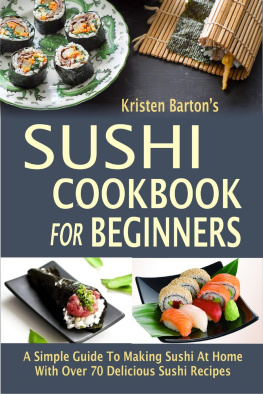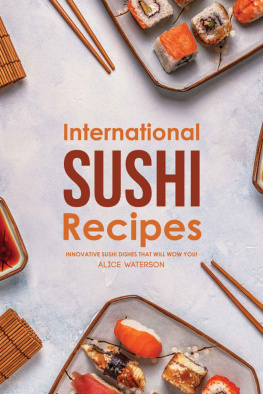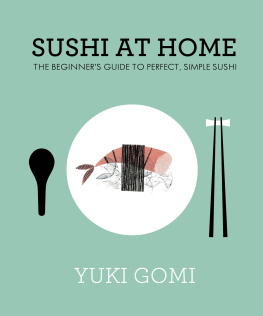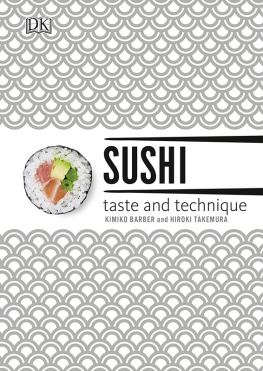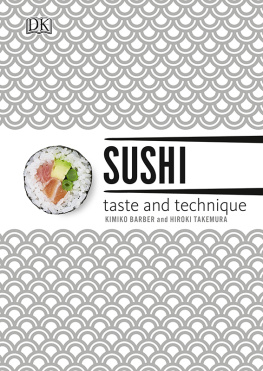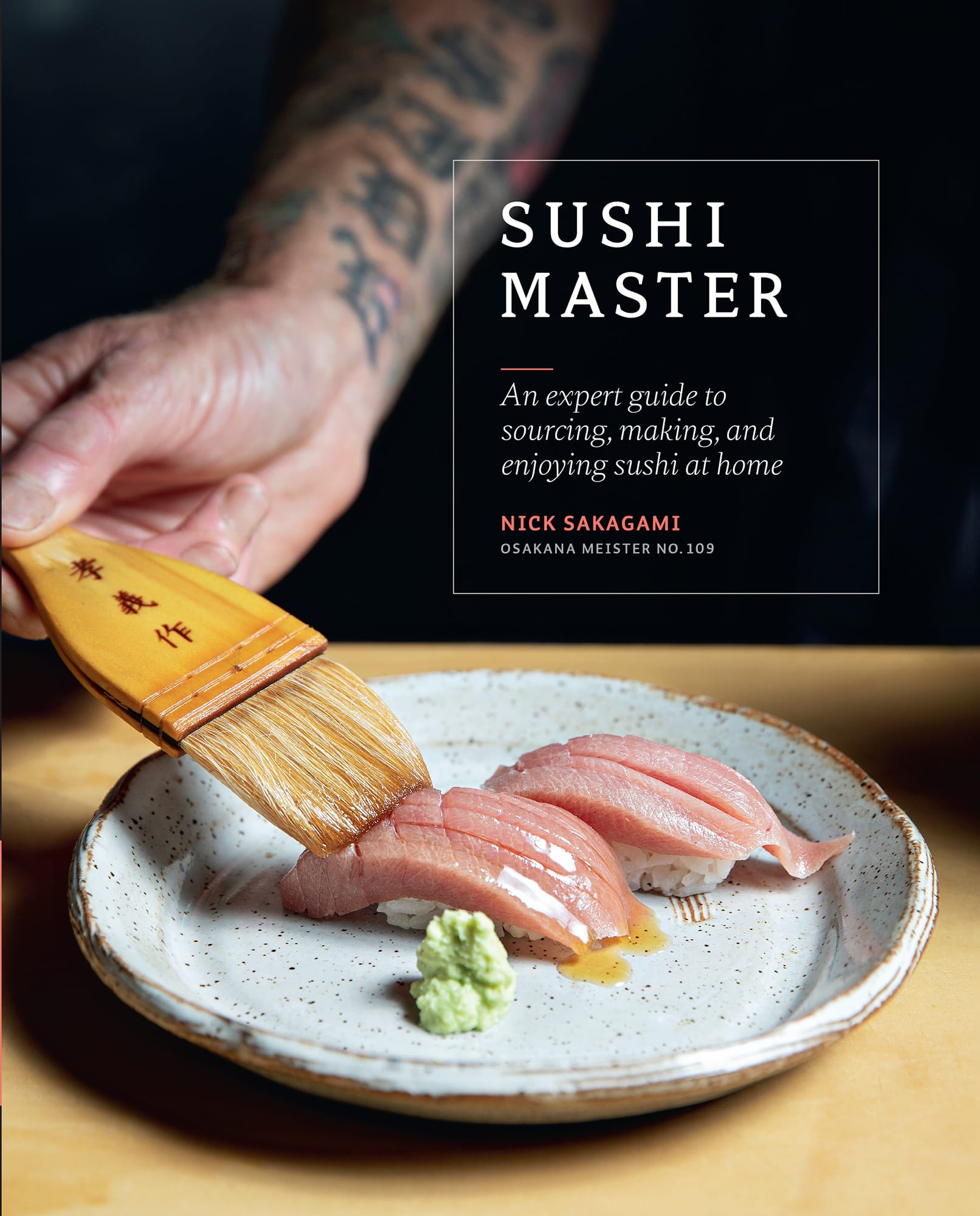SUSHI MASTER
An expert guide to sourcing, making, and enjoying sushi at home
NICK SAKAGAMI
TOYOSU (TSUKIJI) CERTIFIED
OSAKANA (FISH) MEISTER #109

PREFACE
My introduction to fish started when I was youngmy father often took me fishing. In my twenties, I worked for a seafood wholesaler. I smelled like fish. I dreamt about fish. I would become excited just being around fish. This is why, over the years, Ive taken the time to continue my education about fish and become the only person outside Japan to be certified as an osakana meistera fish master.
Today my life is still all about fish. I wake up very early in the morning, on West Coast time in Los Angeles, and get on the phone with East Coast buyers and wholesalers. I work to import fresh tuna from Tahiti, collaborating with local families and the fishing industry there. Then I deal with West Coast buyers, meeting with wholesalers and restaurants to educate them about fresh fish and sustainable practices. Often I do consulting gigs, traveling to San Francisco, Chicago, and New York. I want the world to experience food made from the freshest fish, and I want that experience to be sustainable and possible without too much difficulty or cost.
In this book, you will discover information that only fish wholesalers know. You will learn tips and techniques some people in the seafood industry might not be happy about sharing, such as the best methods for selecting and sourcing fish, the truth about bright pink colored tuna and certain fishing methods, plus how to properly cut fish for your sashimi, from a loin to a block to sashimi pieces, and more. And, by following my advice on how to find sustainably caught fish, you help support the many hardworking, honest, and responsible people working in the seafood industry.
This book is about making sushi at home. When you make it at home, you incur less expense than buying it at a restaurant. As you start making sushi yourself, you will gain an understanding of how detailed the process can be and why the process is as important as the product. This will also offer you a new understanding of what professional sushi chefs do. Another positive outcome of making your own sushi at home: You can eat like a pig and drink like a skunk and not have to drive at the end of the evening. (Its always recommended to pair your food with the local alcoholic beverage, and, in this case, thats sake, of course.) This book also covers the correct ways to eat sushi, so the experience is enjoyed to its fullest.
Because sushi is so very simple, what goes inside the tiny detailsare most important. While I treasure and respect the artistic creations by the master chefs, the basics are attainable and not a big deal. Well, not a big deal when you know how to pick the right fish, slice the fish, and make the basic components of sushi dishes.
Once you learn the basics, there are some advanced techniques if you are curious to learn more. And throughout the book, my dear chef-friends share recipes to bring the whole experience up a notch or two for you.
I also want to introduce how we, the consumers, can play a small, yet important, part in ensuring future generations have fresh fish, so I talk about sustainable fishing practices throughout the book. Seafood consumption is on the rise, globally. The world population is expected to grow. How do we ensure there will always be plenty of fish in the sea?
One book is not enough to cover this complicated and always evolving subject fully. Yet, once you know the basics, you can build upon your knowledge. Different fish, different techniques I hope this will be a gateway to a new chapter of your culinary journey.
Now, lets roll!
The author enjoying a fresh bite at the Tsukiji Fish Market in Tokyo, Japan
INTRODUCTION
What Is Sushi?
At its most basic, sushi, which means, sour tasting in Japanese, is vinegared rice with various toppings. Its origins go back centuries: Salted fish packed in rice was fermented as a way of preserving it. Contemporary sushi, vinegared rice topped with fish, what we know as nigiri sushi, was created as a finger food for the construction workers in Tokyo back in the early 1600s. In need of nutritious food that could be eaten quickly, the workers found this to be the perfect solution. Sushi was a fast food, usually consumed while standing.

SUSHI TODAY
While nigiri was the original form of sushi, today sushi takes many forms. The basic forms are:
Chirashizushi A bowl of sushi ingredients scattered on top of rice
Maki Rolls made with vinegared rice and various ingredients rolled within sheets of nori (seaweed); outside Japan, this is sometimes made with the rice on the outside, like an inside-out roll.
Nigiri Slices of fish on vinegared rice, usually with wasabi
Sashimi A slice of fish that is consumed raw without rice. If you use low-quality fish, it will clearly show. Sashimi is also friendly for low-carb diets, as there is almost no carbs yet tons of high-quality protein in good fish.
Temaki Hand rolls made with sushi ingredients and rice wrapped with a sheet of nori, shaped into a cone
Chutoro, medium-marbled belly of ranched bluefin tuna (top).
Otoro, ravishly marbled belly of ranched bluefin tuna.
Another way sushi has evolved is with regard to the kinds of fish that are popular. Before refrigeration, sushi was made with preserved fish and fish that kept well. Toro, tuna belly, wasnt used for sushi because oily fish didnt keep well. Salmon was not a sushi fish in Japan until about twenty years ago. Now it is one of the top sellers in both Japan and the United States.
Sushi is now available all over the world and in all kinds of places. You can find sushi at grocery stores, fast-food places, and high-end restaurants, where it continues to evolve.
While traditional sushi in Japan is very simple and usually doesnt contain more than one type of fish or vegetable, American-style sushi is more elaborate. Spicy mayonnaise used in sushi is an example of how sushi is evolving. Where Japanese sushi is a delicate balance of flavors, Western diners prefer bold flavors and strong colors, which explains the popularity of a roll such as the Philadelphia roll, which includes salmon, avocado, and cream cheese.
CULTURE AND PHILOSOPHY
Most anyone can create sushi by making a simple rice ball and putting a piece of fish over it. But when sushi is made by a master, it becomes an art form where less is more.



